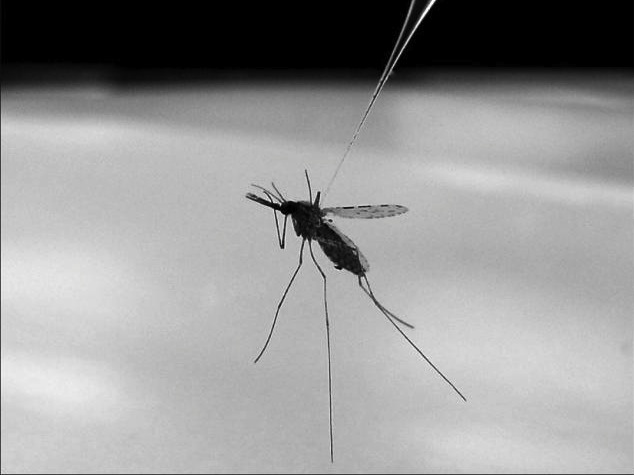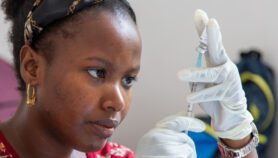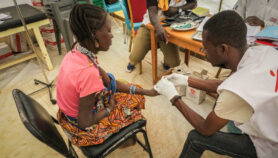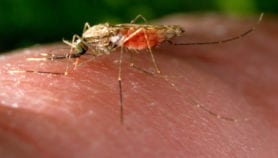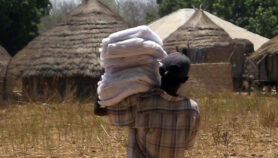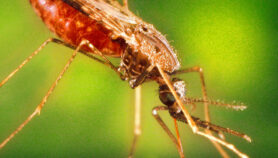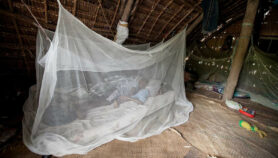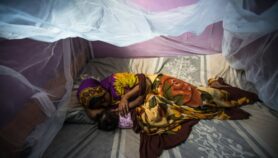By: Katrina Kaufman
Send to a friend
The details you provide on this page will not be used to send unsolicited email, and will not be sold to a 3rd party. See privacy policy.
[BANGKOK] Two international health organisations at the forefront of fighting infectious diseases in the developing world are joining hands to try to produce an innovative vaccine to prevent malaria, which kills hundreds of thousands of people annually.
SciDev.Net speaks to Ashley Birkett, director of the Malaria Vaccine Initiative (MVI), a project of the international non-profit organisation Program for Appropriate Technology in Health (PATH), and B. T. Slingsby, chief executive officer of the Global Health Innovative Technology (GHIT) Fund. The GHIT Fund recently invested more than US$12 million in the global fight against infectious diseases, including a US$600,000 grant to a partnership involving MVI.
Both share their thoughts on the challenges of developing RTS,S, the first possible vaccine available to prevent malaria, and the progress that MVI and GHIT are making in support of the global effort to eradicate the disease.
What is the GHIT Fund, and what is the goal of its grants?
Slingsby: GHIT is a public-private partnership with Japan. Two Japanese ministries provide about half our funds and the other half comes from the Japanese pharmaceutical industry and the Bill & Melinda Gates Foundation. The fund was set up with an initial commitment of about US$120 million for the first five years. GHIT was set up to tap into the capacities, capabilities and technologies that Japan houses in terms of drugs, vaccines and diagnostic development. We did this to advance, discover and develop new technologies for diseases, such as malaria, tuberculosis and other parasitic and bacterial diseases, as well as neglected tropical diseases.
Why are the grants focused on infectious diseases in developing countries, particularly malaria?
Slingsby: As a public entity, or as a non-profit organisation, you’re looking at diseases where the pharmaceutical industry alone cannot develop solutions. These solutions usually are public goods that are not really going to generate a return on investment. So the necessity is to try to advance and create new technologies such as vaccines and medicines, using a public-private partnership model.
Now, why specifically malaria, tuberculosis and neglected tropical diseases? Well, three-sevenths of the world’s population are at risk of these diseases and about one-seventh is actually afflicted with them. So these diseases cause a significant global burden. However, the technologies are not really there in order to eliminate them.
How close are we to coming up with an effective malaria vaccine?
Birkett: Malaria is caused by a parasite. We don’t have any vaccines against the form of the parasite that infects humans, but we’re making progress. Malaria claims the lives of 600,000 young children every year, and there are over 200 million cases. So we certainly need new tools. We have a vaccine — RTS,S — that’s in very late stage development and that we’ve been working on for almost 15 years now with funding from the Gates Foundation and in collaboration with African partners. The vaccine reduces clinical malaria by about 50 per cent in young African children. If everything goes well, that vaccine could be available over the next couple of years. That’s a first step. But we’re working feverishly on what we call ‘next-generation vaccines’ with even higher efficacy, and that’s where the project with GHIT comes in. It’s a strategy to develop an improved next-generation vaccine to prevent malaria.
What are the challenges of coming up with an effective vaccine for malaria?
Birkett: The malaria parasite has a very complex life cycle. It can live in your blood, in your liver, in the stomach of a mosquito. It’s a highly adaptive parasite, so it’s very challenging. But we’re making progress, and having a vaccine with 50 per cent efficacy is a very important first step. When you’re starting from 50 per cent, it shows that you have a lot of knowledge about how to do this. Our goal is to get from 50 per cent to 80 or 90 per cent. I think we do have the biological evidence to develop effective vaccines against malaria, and I’m very confident that we will do that with the support of groups like GHIT over the coming years.
How does the experimental RTS,S vaccine fit within the context of the overall effort to eradicate malaria, and what role do vaccines play in that effort?
Birkett: That’s a really good question. RTS,S was developed originally as a vaccine to prevent malaria, not to eradicate malaria. So the current phase III trial is looking at the ability of the vaccine to prevent malaria especially severe cases in young African children. About 90 per cent of the mortality from malaria is in Africa, most of them children under the age of five. So the strategy was to try to develop a vaccine that would protect the most at-risk population — young African children. Over the last few years, there’s been somewhat of a shift to a renewed focus on vaccines for elimination and eradication. That requires a different type of vaccine, which would prevent infections from malaria parasites or potentially prevent humans from transmitting the parasite to mosquitoes.
MVI is supporting a programme that is looking at vaccine approaches to prevent humans from getting infected when they get bitten by infected mosquitoes, as well as to transmit immunity to mosquitoes so that even if mosquitos feed on infected blood, they don’t become infected. And we have some very promising data to show that’s feasible.
In the meantime, for the next seven to ten years, RTS,S is the vaccine that’s going to be out there. It takes a long time to develop vaccines, so it’s important that we maximise the potential of the RTS,S vaccine. But we also need to recognise that new vaccines are needed. That’s why this partnership with GHIT to identify and develop vaccines with even higher efficacy is a really important long-term goal for supporting elimination and eradication.
The RTS,S vaccine focuses on malaria in Africa. What about preventing malaria elsewhere?
Birkett: Historically, most of the deaths have been occurring among young African children. That’s why RTS,S has been developed as a vaccine focusing on immunising African children as the primary target population to prevent clinical malaria in Sub-Sahara Africa. Now that there’s a renewed focus on elimination and eradication, we can’t just think about where the disease is. We have to think about where the parasite is, and it’s endemic throughout the world. We’ve got to think about South America and South-East Asia, as well as Africa.
Do you believe that malaria can indeed be eradicated?
Birkett: It’s going to take a long time. It’s not something that we’re going to do very quickly. I think we have the tools today to eliminate malaria from certain areas of the world. But to eliminate malaria from the planet, we’re going to need to start investing in new tools. We believe strongly that one of those critical tools is a vaccine. Vaccines were essential for eradicating smallpox. They are also the key tool for the polio eradication campaign. We think it’s going to be the same for malaria.
Is there anything else that people should know about this issue?
Birkett: The last thing I would add is that we’re making progress. We’re on the verge of having the first vaccine available against a human parasitic disease, which is a huge step forward. But we need to do more. We need more-highly-effective vaccines if we’re going to eliminate and eradicate malaria, and that’s going to take more resources. We need more resources to flow into this venture so that we can build on the success that we’ve had over the last ten or 15 years. This whole type of operation has proven that it can deliver products to those most in need, and we’re excited about what the future holds for developing more and superior products.
Slingsby: I think that a lot of this work in terms of global health R&D has taken place in much of Europe and the United States to date. Looking at the economic footprint of Asia in the world right now, more of Asia — not only Japan but China, Malaysia and Indonesia — need to be committed and involved and engaged in global health R&D.
This article has been produced by SciDev.Net's South-East Asia & Pacific desk.


